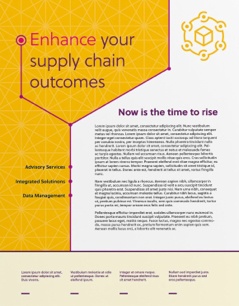Today more health systems than ever are looking to take control of their supply chain processes.
As healthcare systems continue to merge and care delivery becomes more decentralized, providers are increasingly faced with the challenge of cutting costs while balancing increased patient volume with heightened service expectations. All with the constant pressure of declining reimbursements.
What’s more, the shortage of critical medical supplies during the COVID-19 pandemic has further exposed existing supply chain vulnerabilities and the need for healthcare providers to take control of their own supply chains rather than leaning on third-parties.
As a result many health systems are turning to the consolidated service center (CSC) model as a solution. This evolution from a reliance on third parties to self-distribution is a process most other industries have already experienced. Thinking about implementing a CSC? Here are a few systems to add to your checklist before committing to self-distribution - and ensuring that your health system becomes not just successful, but best in class.
1. A Plan for Setup, Flexibility, and the Future
Considering some of the challenges associated with implementing a CSC, a carefully planned strategy is key. Your implementation plan must acknowledge exactly what you want to accomplish, build a strong business case, value proposition, and leave room to remain flexible.
A well-planned strategic initiative includes doing your homework and performing a detailed assessment. Decisions regarding the expenditure of significant capital should be justified with extensive research, analysis and should involve your C-Suite throughout the process. Understanding the financial benefits as well as the costs is crucial. A CSC can result in huge long-term benefits, but the initial investment is often the first major obstacle.
Be sure to ask these questions: How will this improve service to your end users? How will a CSC contribute to better patient care? How will it ultimately result in cost-savings for your IDN and meet your goal of better control of your supply chain?
As your plan begins to take shape, you need to consider how your CSC will operate within the organization. Crucial to its flexibility is taking an agnostic view of the CSC’s operating system, especially given the current climate of healthcare system mergers, acquisitions and joint ventures. There are two choices one could make: A CSC that is subordinate to the ERP, or a CSC that acts as its own ERP, meaning it will operate with the ability to be an arms-length away from the health system ERP. The latter gives your CSC the ability to support any facility whether or not they are on the same ERP. Thus, the CSC can begin servicing these facilities at any time.
With this mindset and an implementation plan in place, you will be better equipped to combat any obstacles you encounter along the way.
2. A Warehouse Management System
A crucial piece to the puzzle in implementing your CSC will be selecting the most effective warehouse management system, or WMS, to manage both inventory and labor within the four walls of the distribution center.
A strong WMS will allow you to minimize operating costs and take control of inventory by cutting labor and space waste, all while helping achieve a paperless environment that directs your employees automatically on the optimal picking, put-away and shipping of your products.
In researching your options, you will find that the breadth of warehouse management system functionality can vary, from basic to extremely sophisticated. As a result of this, some of the tasks fundamental to a CSC simply don’t reside within the WMS.
One such function? An adequate labor management system to capture those activities that occur outside of the WMS. Labor resources usually count as the single biggest cost in operating a distribution center. A labor management system that integrates with your WMS can help track productivity reporting and analyze workforce requirements based on the workload to be performed, giving you the ability to look ahead.
A reslotting solution is another feature that may not reside within your selected WMS. It analyzes your consumption and allows you to get the best use out of your warehouse space and labor. Product changes and velocities happen quickly, as the pandemic has shown us.
Take PPE as an example. An item that once had a normal usage was moved in such velocity that it needed to be relocated within the CSC, meaning this item lost its candidacy for a “prime real estate” position and a higher moving item was put there in its place. From a labor cost-savings perspective, these types of changes need to be able to be routinely accounted for.
If the WMS does not already include these features, you should include integrating these pieces in your plan.
Keep in mind that interfacing the WMS to other hospital systems may not be as easy as your WMS vendor will tell you. The interfaces need to be tested early in your implementation timeline.
3. DMS, TMS, Demand Planning & Forecasting
Once you have your WMS in place, you’ll want to consider three other foundational systems that are integral to operating your CSC: A distribution management system, a transportation management system that includes prrof of delivery and delivery management, and a demand planning and forecasting system.
By monitoring your distribution efforts through a DMS, you gather actionable data about how well your products move from the manufacturing plant to the warehouse and, finally, to the customer.
Sitting on top of the DMS, a Demand Planning & Forecasting system is another tool you’ll need. It analyzes all of the consumption or demand to the hospitals, clinics and sites over a period of time, setting up different forecasting algorithms to then buy inventory into the distribution center in a way that minimizes inventory investment yet maximizes the ability to service the hospital customer.
As the size, breadth, and customer base of your IDN becomes more diverse, you may also want to consider a Transportation Management System. A sophisticated TMS optimizes your inbound supply, looks out over the supplier community at opportunities to consolidate different manufacturing shipments in the same geography, and economically brings things into the distribution system. The visibility afforded by a TMS leads to more efficient transportation planning and execution, which results in higher customer satisfaction.
If it is not part of your TMS, having a delivery management (DM) and proof of delivery (POD) system is essential in managing your outbound freight. Picture the GPS tracking notifications you receive for a UPS delivery – you can see when the truck is on the next block, ready to make a left turn down your street to deliver your package. It’s this self-serve type of information that’s important to the buying customer, whether the customer is a clinician or a busy nurse making certain that the products she ordered are delivered to the home of her patient in anticipation of her arrival.
The ability to provide this of customer service is an area that has not often been tapped into with existing distribution centers – and is one that can absolutely provide competitive advantage. In addition to the before it allows you to manage delivery activities beyond the CSC and schedule and manage reverse logistics to the CSC.
With these basic systems in place, you will be better equipped to operate a CSC and optimize your healthcare supply chain. Remember to know what you what to accomplish upfront, do your research and develop a strong case for business, and be prepared to be flexible. The process will not be easy… Why not have a trusted partner along the way? If you’re considering the implementation of a consolidated service center as part of your overall supply chain strategy, we can help. Contact RiseNow for a free supply chain consultation to help point you in the right direction.




